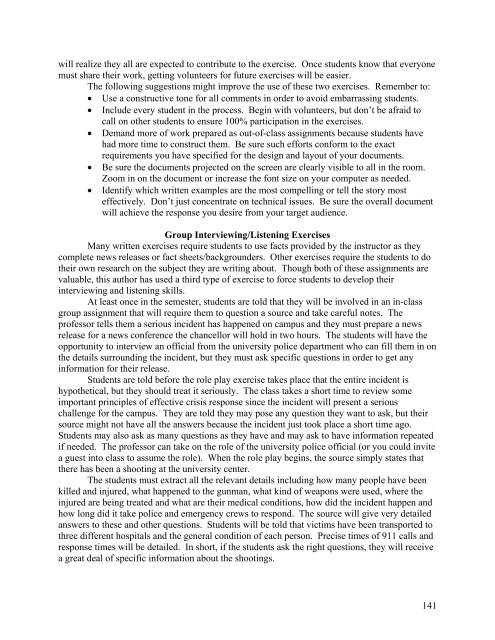2008 PROCEEDINGS - Public Relations Society of America
2008 PROCEEDINGS - Public Relations Society of America
2008 PROCEEDINGS - Public Relations Society of America
You also want an ePaper? Increase the reach of your titles
YUMPU automatically turns print PDFs into web optimized ePapers that Google loves.
will realize they all are expected to contribute to the exercise. Once students know that everyone<br />
must share their work, getting volunteers for future exercises will be easier.<br />
The following suggestions might improve the use <strong>of</strong> these two exercises. Remember to:<br />
• Use a constructive tone for all comments in order to avoid embarrassing students.<br />
• Include every student in the process. Begin with volunteers, but don’t be afraid to<br />
call on other students to ensure 100% participation in the exercises.<br />
• Demand more <strong>of</strong> work prepared as out-<strong>of</strong>-class assignments because students have<br />
had more time to construct them. Be sure such efforts conform to the exact<br />
requirements you have specified for the design and layout <strong>of</strong> your documents.<br />
• Be sure the documents projected on the screen are clearly visible to all in the room.<br />
Zoom in on the document or increase the font size on your computer as needed.<br />
• Identify which written examples are the most compelling or tell the story most<br />
effectively. Don’t just concentrate on technical issues. Be sure the overall document<br />
will achieve the response you desire from your target audience.<br />
Group Interviewing/Listening Exercises<br />
Many written exercises require students to use facts provided by the instructor as they<br />
complete news releases or fact sheets/backgrounders. Other exercises require the students to do<br />
their own research on the subject they are writing about. Though both <strong>of</strong> these assignments are<br />
valuable, this author has used a third type <strong>of</strong> exercise to force students to develop their<br />
interviewing and listening skills.<br />
At least once in the semester, students are told that they will be involved in an in-class<br />
group assignment that will require them to question a source and take careful notes. The<br />
pr<strong>of</strong>essor tells them a serious incident has happened on campus and they must prepare a news<br />
release for a news conference the chancellor will hold in two hours. The students will have the<br />
opportunity to interview an <strong>of</strong>ficial from the university police department who can fill them in on<br />
the details surrounding the incident, but they must ask specific questions in order to get any<br />
information for their release.<br />
Students are told before the role play exercise takes place that the entire incident is<br />
hypothetical, but they should treat it seriously. The class takes a short time to review some<br />
important principles <strong>of</strong> effective crisis response since the incident will present a serious<br />
challenge for the campus. They are told they may pose any question they want to ask, but their<br />
source might not have all the answers because the incident just took place a short time ago.<br />
Students may also ask as many questions as they have and may ask to have information repeated<br />
if needed. The pr<strong>of</strong>essor can take on the role <strong>of</strong> the university police <strong>of</strong>ficial (or you could invite<br />
a guest into class to assume the role). When the role play begins, the source simply states that<br />
there has been a shooting at the university center.<br />
The students must extract all the relevant details including how many people have been<br />
killed and injured, what happened to the gunman, what kind <strong>of</strong> weapons were used, where the<br />
injured are being treated and what are their medical conditions, how did the incident happen and<br />
how long did it take police and emergency crews to respond. The source will give very detailed<br />
answers to these and other questions. Students will be told that victims have been transported to<br />
three different hospitals and the general condition <strong>of</strong> each person. Precise times <strong>of</strong> 911 calls and<br />
response times will be detailed. In short, if the students ask the right questions, they will receive<br />
a great deal <strong>of</strong> specific information about the shootings.<br />
141
















